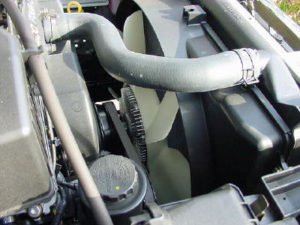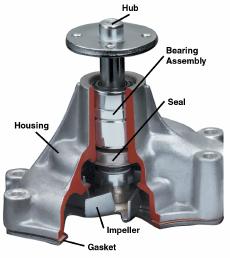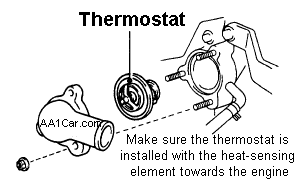
The engine’s cooling system helps the engine manage heat. Hot weather increases the thermal load on the engine’s cooling system and makes it work harder – especially when the air conditioner is also running. Operating temperatures go up and system pressures rise increasing the risk of failure among any weak parts in the system.
LACK OF COOLING SYSTEM MAINTENANCE CAN LEAD TO BREAKDOWNS
According to AAA, cooling system failures are one of the leading causes of vehicle breakdowns on the highway. Yet most such breakdowns can be prevented by preventive maintenance. This includes:Checking the coolant level regularly;Checking the concentration of the coolant;Checking the condition of the coolant;Checking for leaks;Changing conventional coolants every two years or 30,000 miles, or extended-life coolants every five years or 150,000 miles;Inspecting belts and hoses;Replacing any parts in your cooling system that are leaking or failing.Among the items listed above, coolant leaks cause more problems than anything else. Most vehicles today have very little reserve cooling capacity. Radiators and coolant capacities have been shrunken to reduce weight (which helps fuel economy) and cost. Consequently, most vehicles cannot tolerate a coolant leak for very long before the engine starts to overheat. Overheating leads to boilover and even more loss of coolant. It may also cause engine damage as parts swell up from the heat and start to seize and gall. Valve guides can be damaged, pistons can scuff, cylinder heads can crack and head gaskets can be crushed and fail as a result of overheating.Overheating can also occur if the thermostat or water pump fails. The thermostat is a temperature-sensitive valve that regulates the operating temperature of the engine. It speeds engine warm up after a cold start and regulates the flow of coolant between the engine and radiator once the engine reaches normal temperature. The thermostat is usually located in a housing where the upper radiator hose connects to the engine.
WATER PUMP WOES
Water pumps move a lot of coolant, hundreds of gallons per hour mile after mile. The pump shaft and bearings are under constant load not only from the drive belt or timing belt but also the fan on older vehicles with pump-mounted mechanical cooling fans. Eventually the water pump bearings and seal wear out, and the pump begins to leak.If a water pump is leaking, coolant will come out of the weep hole under the pump shaft. A tiny amount of leakage is normal, but a constant drip or stream of coolant is not. A leaky pump should be replaced as soon as possible to reduce the loss of coolant and the risk of overheating. Another reason for replacing the water pump is if the shaft shows any visible wobble or the bearings are making noise.
 Shaft seal failure will cause a water pump to leak.
Shaft seal failure will cause a water pump to leak.Most original equipment water pumps last 60,000 to 100,000 miles or more, but a water pump can fail prematurely as a result of coolant contamination and cooling system corrosion. If the coolant is not maintained and replaced periodically, the corrosion-inhibitors eventually break down. Once this happens, rust and scale begin to attack the pump and everything else in the cooling system. These hard abrasive particles will ruin your water pump seal and bearings. Symptoms of a pump failure caused by coolant contamination include rusty appearing coolant seeping out the pump shaft weep hole and hard calcium deposits around the hole.
HOW TO PREVENT REPEAT COOLING SYSTEM FAILURES
When you replace your water pump, you should also clean and flush your cooling system to remove contaminants. Cleaning with a chemical cleaner is especially important if the system contains rust and sediment. The cooling system and radiator cap should also be inspected and pressure tested to check for leaks. The system can then be refilled with a 50/50 mixture of distilled water and the type of antifreeze recommended by your vehicle manufacturer, or a compatible universal coolant.If your vehicle is older and has a pump-mounted mechanical belt-driven fan with a fan clutch, it’s a good idea to also replace the fan clutch if you are changing your water pump. A slipping fan clutch will reduce radiator cooling and may cause your engine to overheat. If you engine has overheated, you should also install a new thermostat. Excessive heat will often damage the thermostat.
 A new thermostat is recommended if your engine has overheated.
A new thermostat is recommended if your engine has overheated.All hoses should also be inspected when the water pump is replaced, and any that are cracked, bulging, mushy or leaking should be replaced. Hoses that are more than 10 years old should be replaced regardless of how they look. Old hoses are unreliable hoses. New clamps should be installed with new hoses.
RADIATOR REPAIRS
To cool efficiently, your radiator must be clean, in good condition and receive adequate airflow. The radiator’s front-mounted location ensures good airflow when the vehicle is in motion, but at low speeds and when the vehicle is stopped, a cooling fan must be used to boost airflow. On some vehicles, the grill opening is rather small to improve looks and aerodynamics, so an air dam is often used under the front of the car to direct air upwards into the radiator (ground breathers). If the air dam has been torn off or is bent backwards or loose, the radiator may not receive enough airflow at highway speeds to maintain proper cooling.On air conditioned vehicles, a second heat exchanger called a “condenser” is usually mounted in front of the radiator. The condenser cools the refrigerant after it leaves the A/C compressor. The heat given off by the condenser when the A/C is on makes it harder for the radiator to do its job, so the cooling fan usually remains on all the time while the A/C is running.Radiators can usually go 10 years or more without requiring any repairs. But their frontal location makes them vulnerable to damage by stones and other road hazards. They can also become clogged with dirt and debris. In cold climates, road salt can also attack the metal causing corrosion that may eventually cause the radiator to leak. But the most common cause of radiator failure is internal corrosion caused by coolant neglect. If the coolant is not changed at the recommended service intervals, it may become acidic and allow corrosion to attack your radiator and heater core.The plastic end tanks on many late-model radiators can sometimes be damaged by steam erosion. The underlying cause is usually a low coolant level, which may be due to coolant leaks or a bad radiator cap that doesn’t hold its rated pressure.Too much pressure inside the cooling system can also damage a radiator by blowing out the seam along an end tank. The cause is often a leaky head gasket that allows combustion gases to escape into the cooling system. The wrong radiator cap (too high a pressure rating) can do the same thing.If your radiator is leaking, you can try adding a bottle of coolant sealer or stop leak to your cooling system. These products usually work well as long as a leak is small and will plug most leaks temporarily. But for a long lasting fix, you will have to replace your radiator or have it repaired. Even a tiny leak that seeps only a few drops a day will eventually allow enough coolant loss to make your engine overheat.If your cooling system is low and you see no visible leaks at the radiator, water pump or hoses, your engine may leaking coolant internally past a failing head gasket or a cracked cylinder head. These are serious problems that are expensive to repair. The cheapest fix is to add a bottle of head gasket sealer to your cooling system and hope it seals the leak or at least buys you some time. An internal coolant leak can be diagnosed by having your cooling system pressure tested (if it fails to hold pressure, it is leaking internally), or by using a chemical test strip that reacts to exhaust gases in the coolant.Maintenance Tip: You can also use cooling system sealer for preventive maintenance. Adding a sealer to your cooling system even if it isn’t leaking can help seal small leaks as they develop. Many high mileage taxi fleets use this trick to help prevent leaks and overheating in their vehicles.If you have a hose that is leaking coolant, a sealer won’t help. You will have to replace the hose. If the leak is at the water pump, that means a new water pump is needed. Sealer won’t work there either.

Replacing most radiators is fairly easy, but some are part of a cooling module that includes an electric fan and condenser.
A leaky radiator can be taken to a radiator repair shop to be repaired, or you can go to an auto parts store and buy a replacement radiator. Used radiators from a salvage yard are always a gamble and often turn out to be a leaker, too. If you are replacing your radiator, make sure the new radiator is the same size (height, width & thickness), and has inlet and outlet fittings in the correct locations so the hoses will line up. Some replacement radiators may be somewhat thicker or thinner than the original, but as long as it provides the same cooling efficiency (or better) than the original, it should work fine. If you have a “souped up” engine that puts out more horsepower than a stock engine, you should upgrade to a larger, thicker and more efficient radiator to handle the extra heat produced by your engine. An auxiliary electric cooling fan can also help.Always install new hoses if you are replacing an older high mileage radiator. Don’t take a chance with old hoses.
SOURCES: aa1car
